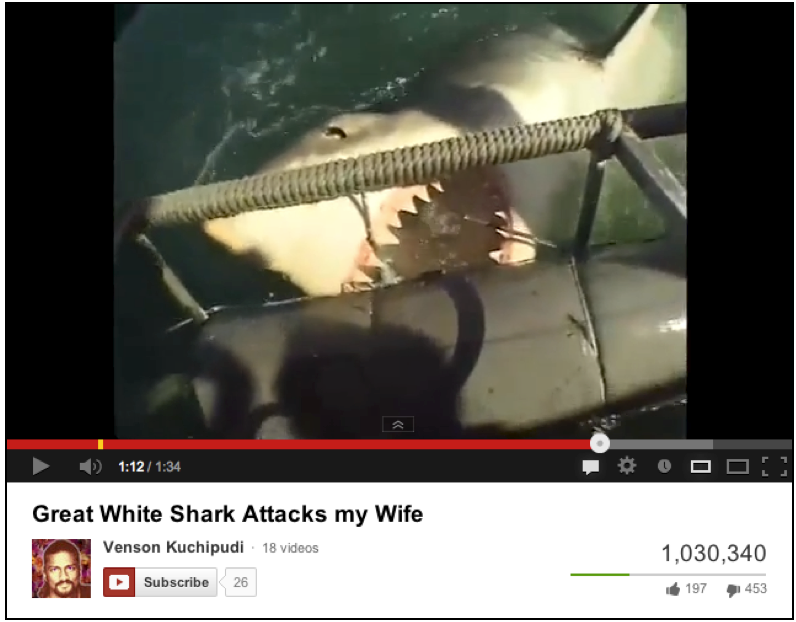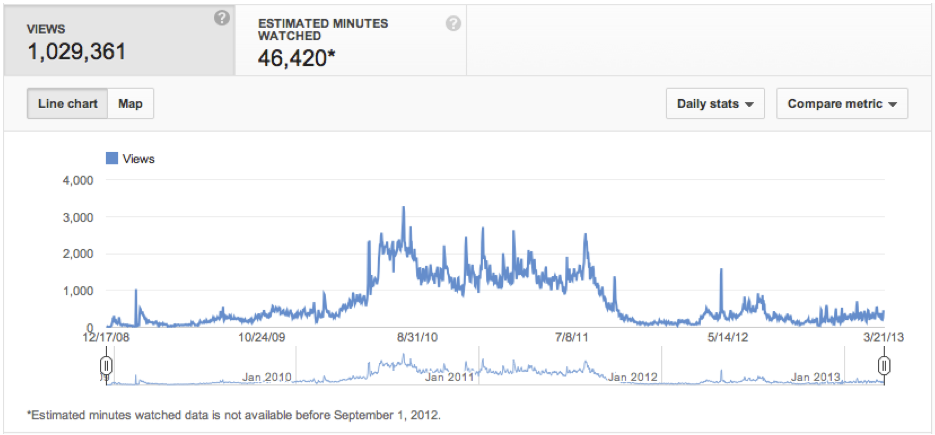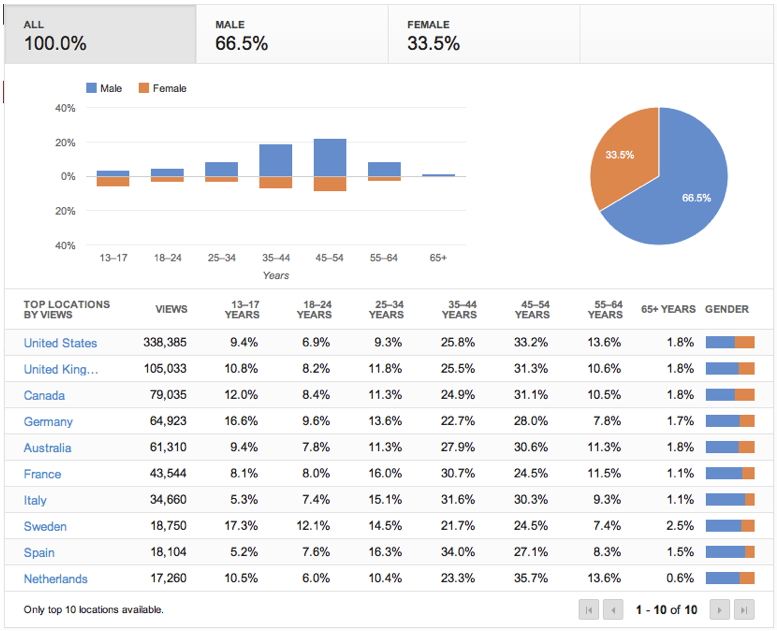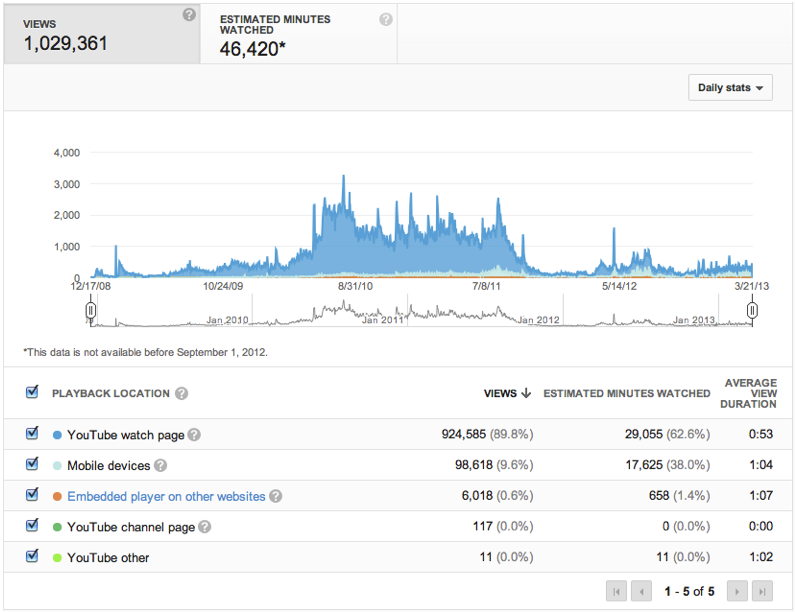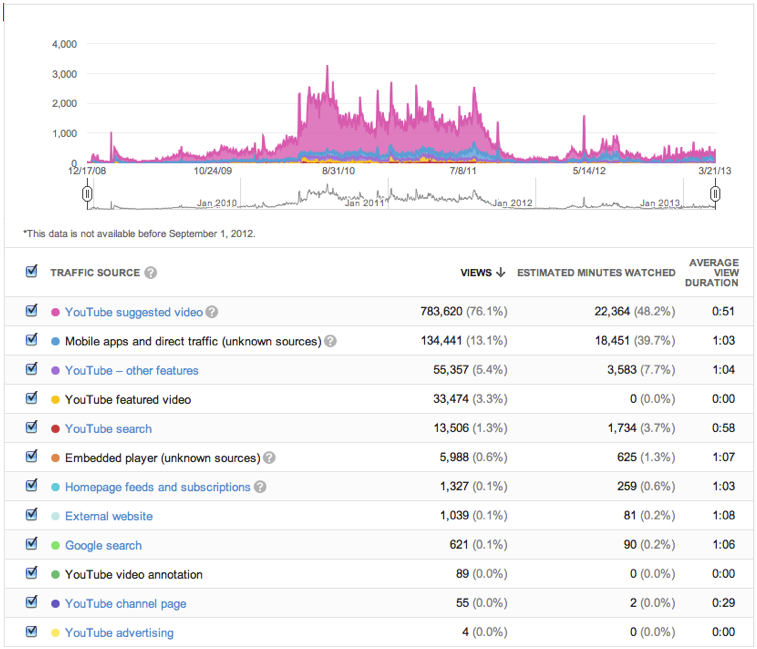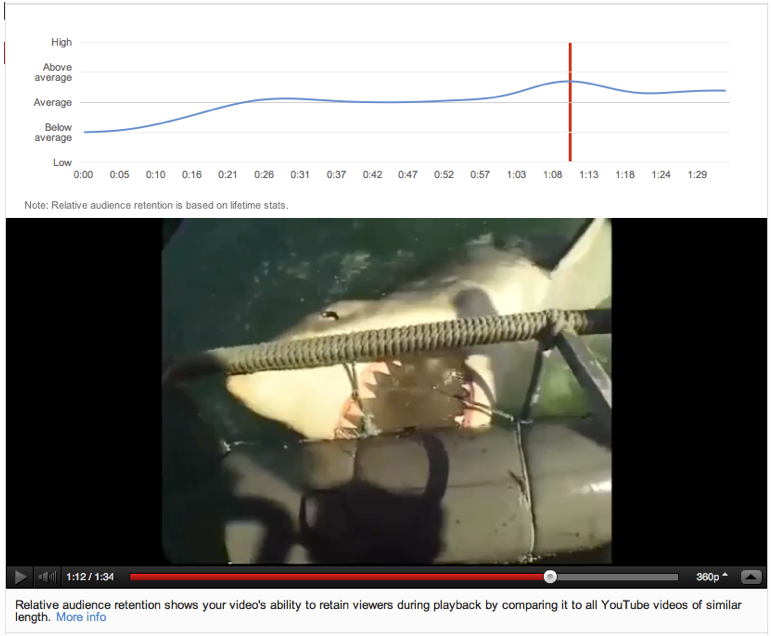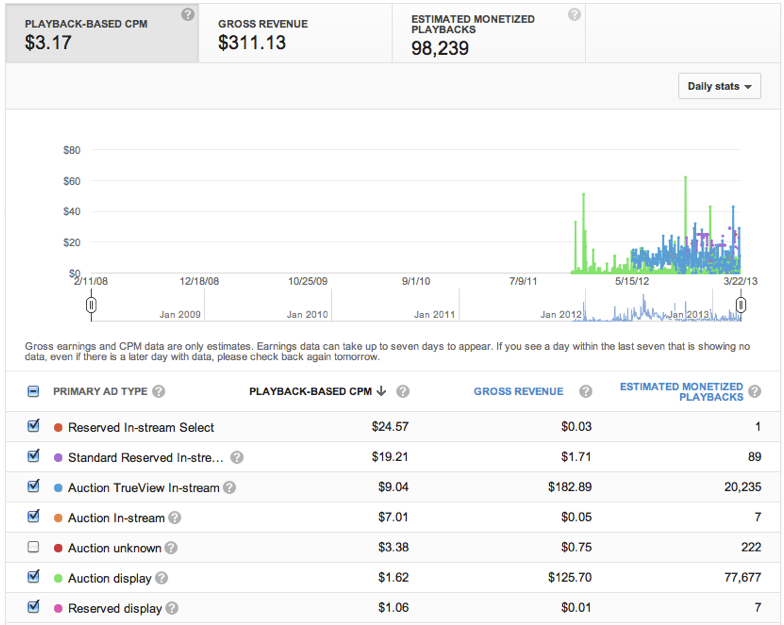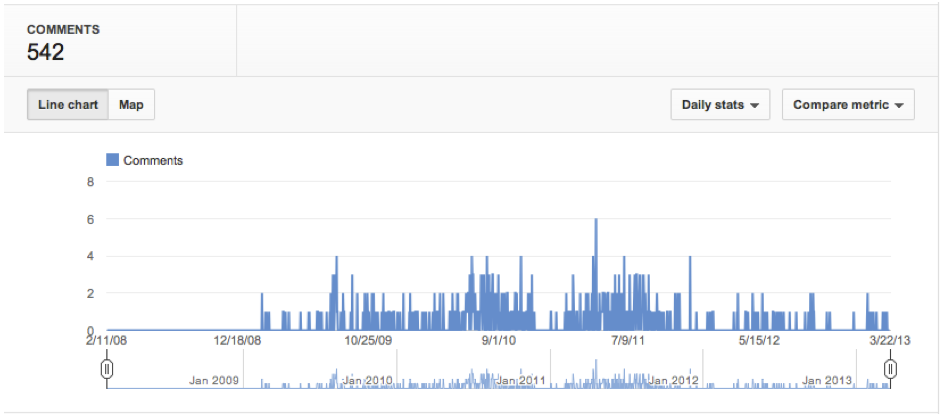YouTube, which is owned by Google, continues to be one of the most utilized websites with over 1 billion monthly users. Nearly one out of every two people on the Internet visits YouTube, as many visitors as Facebook. YouTube is also considered the second most popular search engine after Google, with many people beginning their online searches there, even for traditionally non-video terms.
However, the tools and techniques to use YouTube effectively are not as well known as Search Engine Optimization (SEO) or Facebook marketing. This is primarily due to the amount of functionality that YouTube offers, the continuing changes that YouTube makes to its platform, and the documentation that is deep but difficult to find. This leads many brands to have ineffective YouTube campaigns and low ROI. YouTube is much more than just hosting video; it is a highly engaged community that can drive awareness and conversions faster than any other social site.
There are many tactics for optimizing content on YouTube that fit into brand marketing strategies. This case study explores some of these tactics to see what works and what doesn’t and to determine how to increase ROI for brand campaigns.
Our findings from this case study have helped us optimize channels for some of our key clients including:
Infor: http://www.youtube.com/inforvideo
Aristocrat: http://www.youtube.com/aristocratslots
Overview of Our YouTube Marketing
The Video
Content is king on YouTube and the top content continues to be humor, shock, animal, music, and inspiration related respectively. Brands can promote individual videos, a series of videos called “a show”, or an entire channel (the brand). To test and validate some of our tactics, we chose to promote an individual short animal video and include it in YouTube’s Partner program to see if that increased promotion. We did not focus on promoting a show or the channel itself, however, the tactics we would use for this are included in the Take Aways section at the end of this study.
Results Summary
The existing video we chose to promote, quickly reached 1 million views once optimization began and during the lifetime of optimization was generating between 1000-3000 views per day. Monetizing through the Partner program generated approximately $3 CPM (average gross revenue per thousand) on playbacks. Detailed analysis of the results are included in the Results section further below.
Our YouTube Marketing Plan
Determining The YouTube Channel Design
YouTube’s new One Channel design offers some limited capabilities to brand a publisher’s channel. This includes a logo, a header image, a welcome video and related videos. While this case study focuses primarily on promoting an individual video, brands who want to promote a series of videos or their entire channel should look at these branding capabilities. In addition, YouTube can link a brand’s existing website to their YouTube channel for additional analytics using Google WebMaster Tools. For more information on optimizing a channel see: http://www.youtube.com/yt/playbook/channel-optimization.html
Determining The Video Title
The most important element in an effective video is the title. We utilized standard SEO keyword analysis in determining the title to use for our video. We did the following:
- Determined an initial set of possible keywords to use in the title.
- Searched YouTube with these keywords to find top videos and their titles.
- Created our title from keywords of existing top performing videos on YouTube (for searchability & discoverability).
- Made the title compelling so viewers want to click-through.
Determining The Video Tags
Tags were the second most important element of an effective video. They aren’t as effective for SEO, nonetheless, they are highly effective for search and discovery within YouTube. We included the keywords identified in our title as tags, but we weighted the words for lower competition and higher relevance.
Determining The Video Description
The description is the third most important element of an effective video. Placing key information at the beginning of the description, we described the video to set expectations for the viewer and drive them to watch it in it’s entirety. Also, we included links back to our website and tracked click-throughs via web analytics.
Determining The Video Length
The best practice is to create videos between 2-5 minutes in length for YouTube. After analyzing our users viewing patterns, we shortened our video to under 2 minutes and re-edited it to place the most engaging content within the first one minute.
Determining Engagement Level
Viewers are highly engaged on YouTube, often commenting on videos, more so than on blog posts. However, many comments are self serving or don’t provide any value to the video. During the course of the promotion we allowed comments, but disabled them afterwards due to the high volume.
Our YouTube Marketing Results
Overview
Although our video was generating good views, optimization was key to increasing our views to over 1 million in a short period of time. We tracked and optimized the video for 6 months and noticed a drop off as soon as we stopped optimizing. We attribute this to increased competition on YouTube and the fact that we didn’t focus on building the brand channel or subscribers. Some insights we discovered are:
- Tags were key to high discovery & placement within YouTube, including being listed as a ‘related video’.
- Tags were much more important on YouTube then standard website SEO although the algorithms were similar.
- Although Tags allowed us to categorize our video, YouTube weighted viewer patterns higher in determining the actual search discovery and placement.
- Many viewers didn’t read the entire description based on their comments.
- The description helped SEO just like website meta descriptions – basically optimizing the SERP listing.
Views
Currently our video has 1,030,000+ views and during our promotion, daily views jumped from approximately 500 per day to between 1000-3000 views per day.
Some insights we discovered:
- The highest views occurred during the active promotion of the video.
- Active, on-going optimization was required to keep the momentum of views.
Demographics
As anticipated, our video primarily targeted men, by 2 to 1, in the 45-54 age demographic. It was highly viewed in the US, but spanned many other countries as well.
Some insights we discovered:
- Although most viewers were from the US, the content also resonated with viewers from certain countries and cities, especially cities close to water.
- Younger females also comprised a high amount of viewers and video content in the brand channel could be targeted for them specifically, especially to grow subscribers.
- US viewers from California, Texas, Florida, and New York comprised the most views.
Playback Locations
We optimized the playback specifically for our YouTube channel, however, we also made it available for mobile playback as well as embedding it on various websites.
Some insights we discovered:
- YouTube itself was the primary place people watched the video. This is probably due to people discovering it primarily within YouTube.
- Mobile playback was increasing over time due to increased overall consumer utilization of mobile devices.
Traffic Sources
Our initial assumption was that external sources would provide the majority of traffic to our website. This would include third-party websites and search engines. Instead, we discovered that YouTube itself was the primary ‘search engine’ to discover our video.
Some insights we discovered:
- YouTube’s suggested videos generated the most traffic. So we shifted our tactics significantly, focusing on being suggested by similar videos through tags and promoting other videos.
- Mobile discovery and direct traffic accounted for the second largest traffic source.
- YouTube’s other features such as featured videos and search accounted for the third most significant traffic source.
- Externally embedded videos, including those from search results, accounted for little traffic so we didn’t continue optimizing for this as it seemed more of a long-tail tactic.
Audience Retention
Before optimization, the average view duration was approximately 60% or 1 minute. However, at minute 1:12 in the video had a higher then average retention rate due to its key viewer engagement point.
Some insights we discovered:
- Utilizing the audience retention tool allowed us to see what parts of our video were most compelling to viewers and where drop offs occurred.
- Viewers tended to only watch the first 1 minute of a video to determine if they should continue to watch.
- Understanding at what point in a video viewers drop off helped identify what video content to place first.
- Using video annotations helped keep retention through the mid part of our video, in anticipation of the key moment later.
Earnings
Participating in YouTube’s Partner program allowed us to monetize the video. We experimented with pre, post, and during the video ads. Based on viewer patterns, we decided on pre-roll ads. We continue to average about $3 CPM on playbacks.
Some insights we discovered:
- Using the right tags helped target ads for our video.
- We found that skippable video ads that are inserted before or during the main video performed the best.
Engagement
While our campaign didn’t focus on building a subscriber base or a brand channel, we did see quite a bit of engagement around our video, especially from a younger demographic.
Some insights we discovered:
- Viewers on YouTube comment a great deal on videos, especially if the content is something controversial or disliked.
- Likes or Dislikes didn’t affect the popularity of the video and often Dislikes increased engagement.
- Many comments didn’t add value to the video, so moderation of comments was key.
- Comments are indexed by YouTube and can be leveraged for increasing a video’s promotion or to be listed in ‘trending topics’.
- Most commenters were in a younger demographic.
YouTube Marketing Take Aways
Channel Design
- Channel branding will be key for promoting shows and brands.
- Also channel branding will help drive subscriptions to increase long-tail views of videos.
- Additional resources to optimize a channel: http://www.youtube.com/yt/playbook/channel-optimization.html
- A starting point to creating content effectively is: http://www.youtube.com/yt/playbook/index.html
Video Title/Tags/Description
- Targeting similar videos using the title/tags/description to get listed on ‘similar videos’ was key to driving traffic.
- The use of closed captioning text could add additional descriptions for additional SEO.
Video Length
- Short videos around 2 minutes are more popular but to extend the time, engaging elements need to be placed throughout the video.
- User preferences are continuously changing on YouTube with long-format videos being promoted.
Views
- A consistent generation of views requires ongoing promotion and optimization to keep up with competing videos.
- To keep generating views for the long-tail requires an optimized channel with a strong subscription base.
Demographics
- Localizing content for different countries should be part of a long-tail tactic to increase viewers. This includes closed captioning and modifying titles/descriptions.
- Optimizing the channel for key demographics by utilizing playlists and targeted messaging should also be considered.
Playback Locations
- Any further optimization should include mobile tactics.
- Future playback considerations should also include smart TVs and other devices.
Traffic Sources
- Targeting ‘related videos’ should be an ongoing tactic as more competing videos get added to YouTube.
- Leveraging YouTube’s tools were paramount in optimizing and promoting, more so than standard SEO practices.
- External sources of traffic could be a further long-tail opportunity for traffic and should be optimized as well.
Audience Retention
- Using a test video and tracking audience retention can help optimize the final video for edits, before promotion.
- To keep viewers engaged throughout the video, engaging elements should be placed every 30 seconds. These could just be annotations.
- Videos should lead in with some compelling content, within the first minute, to engage the viewer to continue watching. This includes limiting the brand title and intro lead-in.
Earnings
- Test should be performed with additional tags to see if CPMs increase.
- Tags should match popular/competitive ad words found using Google Adwords Tool.
Engagement
- Increasing Likes will help feature the video better within YouTube.
- Promoting favoriting and sharing of video should be included as another tactic to increase video views from friends-of-friend viewers.
- Managing comments is a good way to build and promote shows as well as channels and should be part of any strategy focused on increasing subscribers.
- Managing comments requires community management skills and requires dedicated resources.
- Building a subscriber base will be key to building the long-tail community for the brand channel and drive new video views from existing viewers.
- Utilizing the new InVideo Programming to feature videos or branding within other owned videos.
The YouTube Partner Program
Overview
The YouTube Partner Program is an opt in program that helps publishers increase their video effectiveness. The account we used in this case study was part of the Partner Program. There are additional requirements and verifications you and your content need in order to be accepted into the program. The primary reason people do so is to monetize their videos and gain international support. Some of the key program elements include:
- Allowing a greater reach for your videos with additional promotions (like featured videos) by YouTube and inclusion in special advertising programs, both online and offline.
- The ability to monetize your videos and add product placements within those videos.
- Access to development programs and analytical tools.
- Networking and collaborating with other publishers to share and gain insights.
- A non-exclusive agreement with YouTube, but not other Multi-channel networks (MCNs) of YouTube. Meaning that you can distribute your videos on other sites, but not through other MCNs within the YouTube.
Monetize
Note that you must own all the rights in the videos to monetize videos, including:
- Music
- Graphics and pictures
- Movie or TV visuals
- Video game or software visuals
- Live performances
Partner Features
- Custom thumbnails
- Live streaming
- Merch annotations (product placements links in videos)
- YouTube shows (episodic videos)
- Monetization through rentals
Partner Programs & Rewards
- Video Creation Marketplace to attract and to partner with advertisers.
- Partner rewards ($500 B&H gift card, custom DSLR camera case, plaque) for reaching certain subscriber levels.
- Automatic Promotions through Featured Videos, Ad units on the Google Display Network, other YouTube promotions both online and offline.
- Ability to become YouTube certified to help other publishers.
